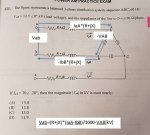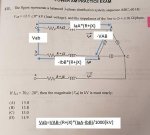Hey guys,
I'm looking for resource/book/practice problems/youtube in solving three phase WYE/DELTA, DELTA/ WYE any combination of line/phase voltage current problems for my PE exam. I have no problem with magnitude, I know when to apply root 3 etc, the problem is with angles.
For e.g. Problem like this.

I'm looking for resource/book/practice problems/youtube in solving three phase WYE/DELTA, DELTA/ WYE any combination of line/phase voltage current problems for my PE exam. I have no problem with magnitude, I know when to apply root 3 etc, the problem is with angles.
For e.g. Problem like this.






